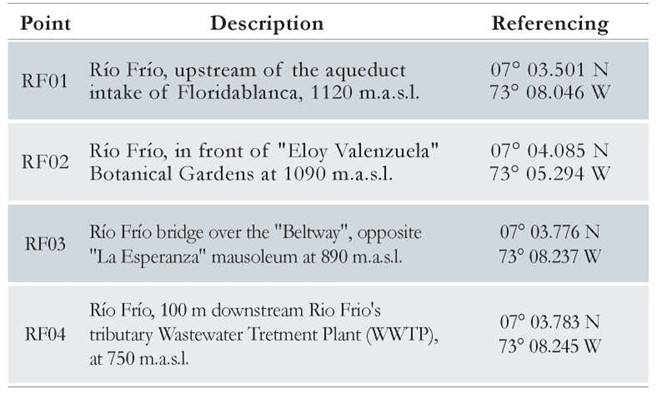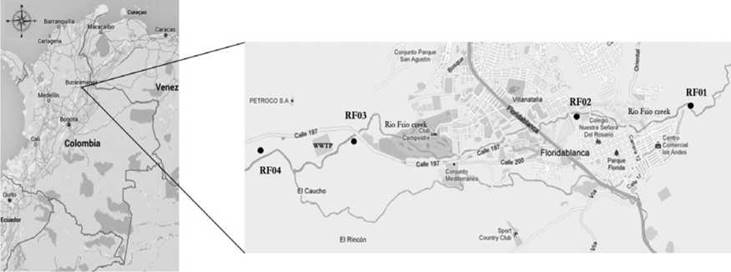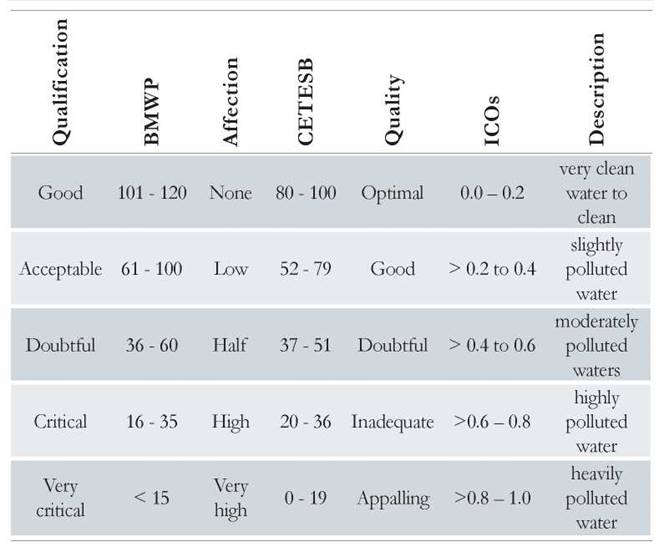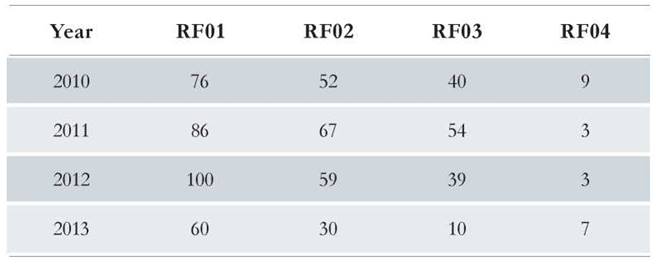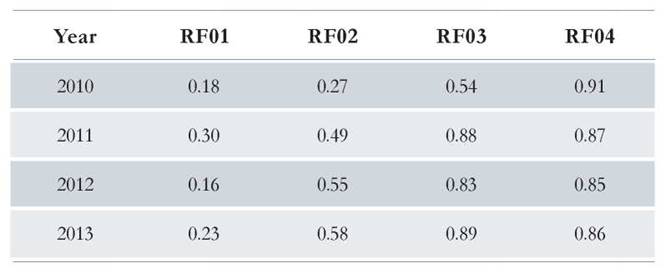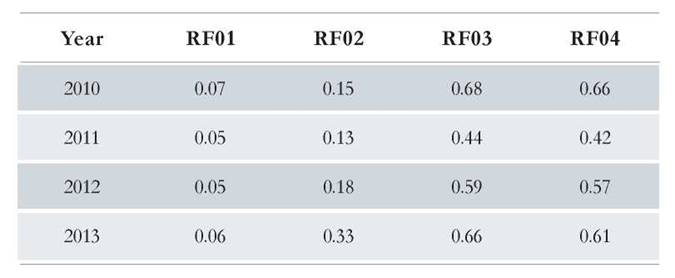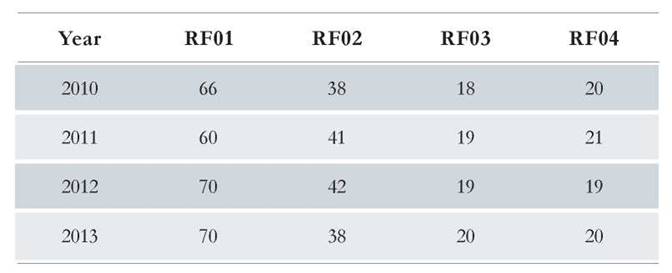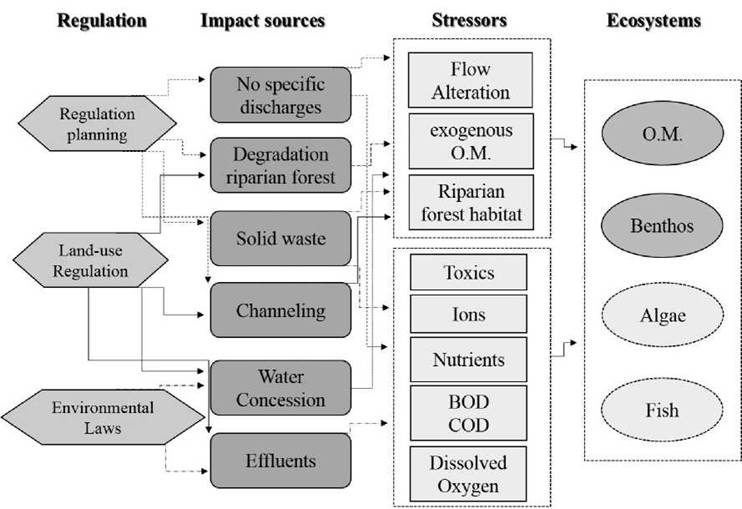Introduction
Urban population is increasing, and competition over the same natural resources (air, water and land) augments for all human needs of life, production and recreation. Therefore, urbanization requires conservation of the watercourse for obvious reasons: supply source availability for irrigation and domestic use, for construction and building material production such as sand, wood, stone, as a means of transportation, for disposal of liquid and solid wastes, or for simple landscape enjoyment, among others [1].
For more than 15 years the Corporación Autónoma Regional para la Defensa de la Meseta de Bucaramanga (CDMB) has been physico-chemically monitoring rivers and streams in their area of surveillance, which includes the metropolitan area of Bucaramanga and some surrounding municipalities [2]. The basin of Río Frío has been assessed based on the Water Quality Index ICA-CETESB (Companhia Ambiental do Estado de São Paulo) diagnostic criteria developed by the Environmental Agency of the State of São Paulo [2]. In addition, since 2011 they include in the analysis -ICO- Pollution Indexes [3,4,5] for further result interpretation. Moreover, these indexes contribute to establish pollution components received by Río Frío [6].
Rio Frio’s Micro watershed has a length of 30.1 km, encompassing an approximate area of 11 890 hectares, with altitudes ranging from 700 to 3 000 meters above sea level. Established rainfall ranges between 1 000 to 2 000 mm, with temperatures fluctuating from 10 ° C to 25 ° C. Therefore, these environmental conditions define various climatic zones from seasonal dry tropical forest (bosque seco tropical, bsT) to Tropical High Andean Wet Forest (bosque muy húmedo alto Andino Tropical, bmhAAT). The project herein described was developed between subandean wet forest thermal floors (bosque húmedo subandino Tropical, bhSAT) and seasonal dry tropical forest [7].
In 1975 the Environmental Agency of the State of São Paulo (CETESB) adapted and developed its Water Quality index from the National Sanitation Foundation (NSF). To date it retained nine variables considered relevant for water quality assessment. The final water quality value corresponds to the sum of each total value with its weighting factor parameter, categorizing water quality with values ranging between 0 and 100 [8].
Other indexes taken into account are the mineralization contamination index (índice de contaminación por mineralización ICOMI) integrating hardness parameters, alkalinity and conductivity. Additionally, to quantify the degree of water pollution resulting from organic matter the index of organic matter (índice de contaminación orgánica ICOMO) takes into account 5-day biochemical oxygen demand (BOD5), fecal coliforms, and saturation of dissolved oxygen. Therefore, both indexes are associated with water bodies’ conditions, with values fluctuating between 0.0 and 1.0 [5]. These values combine water fundamental properties, and are variables regularly determined in any limnological or environmental study. Collectively, one index is related to minerals and the other to organic matter, and not to specific pollutants. Even though these indexes are not taken into account by the Colombian National legislation, they become relevant, as their parameters are highly important for water quality assessment [4].
Furthermore, the quality of water can be determined based on macrovertebrates as biological indicators, as it is appraised by the BMWP/Col index [9]. This index considers different values of qualification per family, whose total sum identifies the type of water quality [10]. Organic pollution effect on Macrovertebrate fauna in Ecuadorian highland streams was studied by Jacobsen in 1998[11], with a validation range between 1 and 10, also considered in the present study.
A bioindication value must be determined, considering biotic, as well as abiotic or physico-chemical components, when establishing the real impact of polluted effluents into water bodies [12]. Bioindication is an economical and reliable tool to validate the quality of water resources, the potential of its use, and the degree of contamination [12]. In Colombia, in general this methodology has become a priority for water and aquatic systems quality diagnosis [13,14].
The first bioindication research on Río Frío was conducted in 2004 by two students of Biology at the Universidad Industrial de Santander [7], establishing a base for the biological and physico-chemical status of Río Frio’s quality. Years later, the Unidades Tecnológicas de Santander -UTS- jointly with the CMDB developed a research project applying bioindication [15], proposed by Riss, Ospina and Gutiérrez (2002) [16], complementing with BMWP index application.
For this research Río Frío’s water quality in was determined by applying BMWP/Col and physical and chemical indexes. The aim of this study was to identify the environmental impact on this stream generated by the Metropolitan Area of Bucaramanga (MAB) urban growth.
Materials and methods
Study area
Four (4) fixed sites were selected for Rio Frio sampling, specifically i. upper middle basin (RF01, aqueduct water intake), ii. two samples collected from the middle of the course evaluated (RF02 and RF03), iii. at the lower basin (RF04) near Rio Frio tributary to Rio de Oro.
Data is presented as mean of samples collected during a period of four years from 2010 to 2013. During this time two distinct weather conditions prevailed: rain or drought, taking into account also transition periods between these climates.
Water quality of this urban stream was monitored over a period of four years to determine Metropolitan area of Bucaramanga urban development and growth effect on the quality of Río Frío water. Table 1 shows the nomenclature and description of the sampling sites as follows:
Location of Río Frío sampling sites is presented in Fig. 1
Macroinvertebrate sampling
Macroinvertebrates samples considered different biotypes selected in situ at each collecting site (rapids, backwaters, expansion, vegetation on stream’s bank, under rocks, and submerged leaves, etc.). An exhaustive sampling (presence or absence of biological indicators) was performed using the Kick sampling method each day [17]. In addition, other collecting methodologies were used: manual or employing a 0.25 m2 D-net with a 450 jm mesh. Collected organisms were preserved in plastic containers in transeu solution [18], and transported to the laboratory for identification. Macroinvertebrates were classified up to the f amily l evel, using a Zeiss stereoscope, taxonomic characters and field guidelines [19-23].
Biological index, BMWP/Col (Biological Monitoring Working Party, modified for Colombia) was calculated according to the methodology proposed by Roldan for data analysis and to demonstrate the environmental impact generated on the receiving body (2003) [13]. For biotic indexes, BMWP and ICA-CETESB, values range from 0 to 100. In contrast, ICOs values fluctuate between 0.0 and 1.0. Each value range establishes a quality of the water (Table 2).
Physico-chemical indexes
To calculate physico-chemical indexes ICA-CETESB and ICOs values of annual reports tracking quality of watersheds developed by CDMB certified laboratories were taken into account [2,6,24,25]. Applied qualification indexes were contrasted and presented in Table 2.
Statistical analysis
To establish possible statistical significant differences between index values one way ANOVA was performed. Significance was considered with p < 0.05 (5 %, a = 0.05). To identify sample means differences from each other a post-hoc Tukey HSD test was performed. For all analyses BioStat software, version 3.8 was used (2007). The hypothesis to be tested was monitoring sites would show a decreasing trend for all indices in a downstream direction.
Results and Discussion
During the four years of collecting samples invertebrates were identified belonging to three different phyla: Annelida, Mollusca, and Arthropoda, corresponding to five classes, 14 orders, and 51 families. Organisms belonging to the Clitellata class and Oligochaeta sublass were identified among the earthworms. In the Mollusca phylum, organisms belonged to the Gastropoda class, and for the Arthropoda phylum insects were collected. In total 51 families were determined.
Indexes
Water quality in established range values were assessed using the BMWP/Col., ICA-CETESB, and ICO’s indexes. Values obtained were the result of contributions received by the stream on the course evaluated, determining pollution levels for each site. For the four years of sampling the highest BMWP calculated values were for sampling site RF01, followed in order by the second, third, and last fourth (Table 3). Supporting these data are physico-chemical evaluations through ICOMO index values, illustrating the level of discharged organic matter into the body of water (Table 4), which rose from RF01 to RF04. In addition, emptied into Río Frío course were minerals, also increasing for each year from RF01 to RF03, and then sustaining a similar value for RF04, as determined by ICOMI index values (Table 5). However, the association between BMWP and ICA-CETESB index values was not observed, due to the integration of parameters necessary for its application.
ANOVA analysis showed significant differences for all index values herein presented, with values of F = 17.71 and p < 0.05 for BMWP values. Furthermore, for ICOMO values an F = 136 and p < 0.05. For, ICOMI index values F = 36.97 and p < 0.05. Last, for ICA-CETESB index values an F = 284.45 and p < 0.05 values. Tukey post-hoc test established for all cases RF04 site was the location mainly establishing this difference.
As evidenced by BMWP index values (Table 3), and physico-chemical indexes (Tables 4, 5, and 6) water quality diminished as the course approached the stream’s tributary site, from the RF01 (aquatic system intended for drinking water intake) to RF04 (water below the shedding of Rio Frio's waste water treatment plant WWTP). BMWP index showed a detrimental effect on water quality by the presence of macroinvertebrate groups more tolerant to contamination (Diptera order and Oligochaeta subclass), confirming our hypothesis. This severe change was mainly due to effluents coming from Río Frío wastewater treatment plant. In agreement with our findings Baa-Poku, et al. 2013 reported similar findings for an urban river in Ghana [26], and De Jesús-Crespo and Ramírez, 2011 for urban rivers in Puerto Rico [27].
Furthermore, information obtained from sampled organisms is associated with their environment. Therefore, their slow locomotion is suggestive of water quality conditions. In contrast, values obtained from physico-chemical indexes, such as ICA-CETESB and ICOs, correspond to parameter values at the time of the sample was taken. Moreover, values can change throughout the day. However, when physico-chemical values remain unchanged year after year, it is indicative quality was maintained within designated range (Tables 4, 5 and 6). Characteristics for each index require an integrated analysis and diagnosis. Thus, information from biotic index and physico-chemical indexes must be complementary to have a better interpretation of the results.
This explains the possible discordant BMWP 2013 RF01 site value of 60 (of doubtful quality) in contrast to suitable 0.30 and 0.23 (good quality) ICOMO values for RF01 for 2011 and 2013, respectively. Presence of macroinvertebrates indicates a permanent condition, illustrating the history of the water quality, while water physico-chemical parameters correspond to conditions at the time of sampling.
Obtained results reveal the impact of the metropolitan area of Bucaramanga “MAB” demographic and urban growth on Río Frio’s water quality. According to the CENAC statistical bulletin, between 2009 to 2012 MAB population increased by 25 % compared with the census conducted in 2005. The rate of housing production was maintained at 5.56 per 1 000 inhabitants, with 31 600 residential units built during the four years of this study. Construction area approval increased 80% in 2012 in comparison with 2009, with an urban growth of MAB expanding to the municipalities of Floridablanca and Piedecuesta, south of Bucaramanga’s metropolitan area [28].
These urban dynamics can be evidenced by obtained results. Taking into consideration RF01 site had the lowest urban incidence, and is the same site for water intake by the city Water Works, water quality over the years should be maintained with "good" or "not affected" values. However, BMWP values of 76, 86, and 100 were acceptable from 2010 to 2012, yet were doubtful in 2013 with a value of 60 (Table 3). A study by UIS in 2005 revealed the quality for this site was "good" (BMWP > 101). This should be the recommended value in a water course system destined for drinking water intake, and not lower, as was observed in 2013.
Urbanization processes involve a great impact on urban river banks, they disturb protection forests, change the quality of waters due to construction activities, causing runoffs loaded with solids and ions. These urban stressors were evident in BMWP/Col index results, as macroinvertebrate structure and permanence was affected. This issue was also raised by several researchers involved in the last Symposium on Urbanization and Stream Ecology (SUSE) held in May 2014 [1].
Comparison between RF01 and RF03 results in Table 3 for 2013 substantiate this discussion. RF03 is the site after Río Frío has already toured MAB urban area; it demonstrates BMWP values changed from doubtful (60) to very critical (7). This definitely d elineates the impact generated on macroinvertebrate community in this course of the stream. This fact is also reflected in ICO’s index, more evident for the ICOMO index value, where rating changed from low (0.23) to very high (0.86). Most critical, for the last three years its value describes very polluted waters (Table 4).
At the RF04 site, downstream effluents poured from Water Works treatment plant, in addition to all the pollution Río Frío has received on its course through MAB, results in "very critical” and "very high" pollution as established by BMWP and ICOMO index values, respectively. This point was most critical, showing a clear difference between values before the suburban (RF02) and urban site (RF04).
Furthermore, ICOMI results ranged from "medium" to "high" pollution (Table 5). The values for this index demonstrate a medium level of minerals drained into Río Frío. In comparison with organic matter ICOMO index values (Table 4), mineral index values were lower.
Additionally, the treatment plant for Río Frío domestic sewage -WWTP- (Operated by EMPAS), purifies d omestic w astewater for a bout 60 % of Floridablanca municipality population, thus pours water with high organic matter content and minerals into Río Frío. For the stream not to be polluted sufficient depuration for receiver body is expected, validating its downstream use.
At present, the MAB is drastically growing towards the municipality of Floridablanca. Therefore, Río Frio’s WWTP is investing to meet new urbanized areas, and improve treatment of domestic sewage efficiency [29].
Results shown by ICA-CETESB index (Table 6) show a similar tendency to those observed for BMWP/Col., and ICO indexes. However, a more profound analysis disclosed the site that should have the worst conditions (RF04) was actually "inadequate". It was expected to obtain "appalling", as was observed for 2012.
This situation is mainly due to two circumstances proper of ICA indexes. The first is its calculation requires a weighting. It weights physico-chemical values according to their importance. These values are multiplied and added-up to the water parameter value to assign the final rate. The second is ICA-CETESB index integrates additional parameters evaluated in the ICO’s (pH, total phosphorus, total nitrogen, turbidity, temperature and total solids), which can vary the qualification value [30]. However, it is important to clarify that values of 19 and 20 of this index are in the limit between "inadequate" and "appalling". Given the conditions, it could be said water with this qualification should be considered "appalling".
These two features make ICA-CETESB key parameters to go unnoticed or less evident by the weight and integrity of ICA index calculation. Not so for ICO’s, as these indexes rate groups of parameters independently from weighting. Moreover, they depend on the parameter’s concentration value and its impact on the water body.
Last, to grant construction licenses environmental studies must be performed. However, these studies are not aimed at protecting the environment, as is contemplated in the Federal environmental requirements for construction in the United States of America [31]. Under such guides, useful information regarding storm waters runoff, solid and hazardous wastes, and other important environmental issues are written primarily for general contractors. In contrast, in Colombia the "Formulario Unico Nacional" is concerned with landslides threats and risk of flooding. The impact construction generates on bodies of water should also be taken into account in this guide. Therefore, with this single environmental study, it is not possible to predict the impact urban growth will generate on water bodies.
Conceptual model of impacts on Río Frío stream
Using Wenger et al. 2009 proposed guidelines [32], a conceptual model was structured to establish possible impacts Río Frío receives as an urban stream pilot (Fig. 2).
Likewise, it also serves as guidance for impact identification of urban growth on rivers at a regional level. The diagram is divided into four columns. The first column -regulation- determined regulation instruments involved in urban activity. These include land use planning, which takes into account actions exerted by curators, regional and national territorial planning (plan de ordenamiento territorial POT), and current Colombian environmental legislation to protect water, air, soil, and watersheds, among others.
The second column identified sources of impact along the basins. Within this category the first three are related to human urban activity, and the last two to those directly related to legal procedures. The third column determined attributes generating stress in aquatic communities, named stressors. Two types of stressors were acknowledged: exogenous or outside the water or on river or stream banks (water flow alterations, exogenous or external organic matter, - also named contributions - and alterations of riparian forest or gallery forest, accompanying basins). The other type of stressor is endogenous, present in the water column (toxic ions, dissolved gases, nutrients, endogenous organic matter, etc.). Stressors are the result of impact sources. Some may be more influential than others, for example, alteration of riparian forest can have an effect on flow disturbance and the contribution of ions or nutrients to the river [33,34] in contrast to normal flood fluctuation of the riparian zone.
The last column describes ecosystem components, such as endogenous and exogenous organic matter. In addition, elements of the ecosystem also involve freshwater communities: benthos, fish, and algae. In the present study only benthic macroinvertebrate fauna, organisms that live and develop in the bottom of rivers or lentic systems, was studied [14].
The ecosystem and its components respond to stressors. Additionally, depending on the component level so can be its impact. Wenger etal. 2009[32] categorized three states of ecosystem alteration: (1) Minimum disruption: streams maintaining their original structure and function or one that has been restored. (2) Moderate impairment: significantly altered flows, with structure and function of modified ecosystem, yet still provides multiple ecosystem services. Usually urban rivers outside dense urban or suburban centers, last (3) Severe Disruption: watercourses that have lost every species susceptible to pollution and only the most tolerant remain. Nevertheless, the system provides some ecosystem services. As a case in point, channels for carrying off rain water as a source of fresh water for dilution of pollutants.
Collectively, according to the results obtained for Río Frío stream, the following can be established: at RF01 site the stream still has some attributes. However, it is beginning to show human disturbance at this suburban location, with minimal disruption. At RF02 the stream is intervened by urban growth in the northern part of the municipality of Floridablanca (Fig. 1). Thus, it begins to show moderate alterations with loss of sensitive communities. Last, at RF03 and RF04 sites severe alteration conditions are present. Therefore, susceptible macroinvertebrate communities are incapable of living under such polluted conditions, and only the most tolerant communities survive. At RF04, downstream of Río Frío wastewater treatment plant discharge, the most tolerant communities are almost absent. This clearly demonstrates the level of urban disturbance the stream receives before its tributary to Río de Oro. Most concerning Río Frío has lost all its ecosystem services.
Lastly, this work allowed us to establish the high impact urban growth has on bodies of water surrounding or flowing through cities. Many streams or rivers are used by a city’s water works as a supply for drinking water intake. However, at the same time polluted effluents are also discharged into river waters. Therefore, the possible impact of urban growth on a body of water quality is not taken into account. Hence, a city expansion considered as “development”, does not take into account its consequences on the ecosystem.
Establishment of effluent discharge effect on a body of water, from an industrial or other activity, must consider abiotic or physico-chemical components, as traditionally envisaged. Nonetheless, biotic components of an aquatic ecosystem are an indispensible diagnostic factor, allowing for bioindication [12].
Conclusions
The monitoring carried out during four years of sampling to determine BMWP/Col. and physico-chemical index rates unveiled a marked change in the quality of Río Frío waters; starting from the upper part of the basin, a suburban location where the water works use its course for drinking water intake to the vicinity where Río Frío becomes the tributary of Río de Oro. The greatest impact on this urban stream occurs where its course flows through the metropolitan area of the city of Bucaramanga, where Río Frío receives the greatest anthropic and urban action: deforestation of riparian forest, temporary and clandestine discharges, channeling, and modification of its riverbed.
The RF04 site was located downstream of the wastewater treatment plant (WWTP) discharge into Río Frío. Data demonstrated the WWTP is an important organic load and mineral contributor to Río Frío, resulting in heavily polluted water. This situation is not in compliance with environmental legislation. Implemented domestic water treatment systems should observe decrees, and regulatory bodies should maintain vigilance and control to prohibit and prevent this situation.
For water quality evaluation application of biotic and physico-chemical indexes demonstrated with greater certainty potential impacts generated on an urban stream. Integrating different components become a valuable tool for assessing water quality and environmental impact of different stressors (exogenous) that converge on urban water bodies.
In conclusion, this study established the impact urban growth generates on bodies of water surrounding or flowing through cities. Therefore, a water environmental strategy should be implemented. Thus, urban planning permits must include monitoring programs of water courses that will be intervened by urban construction projects.













